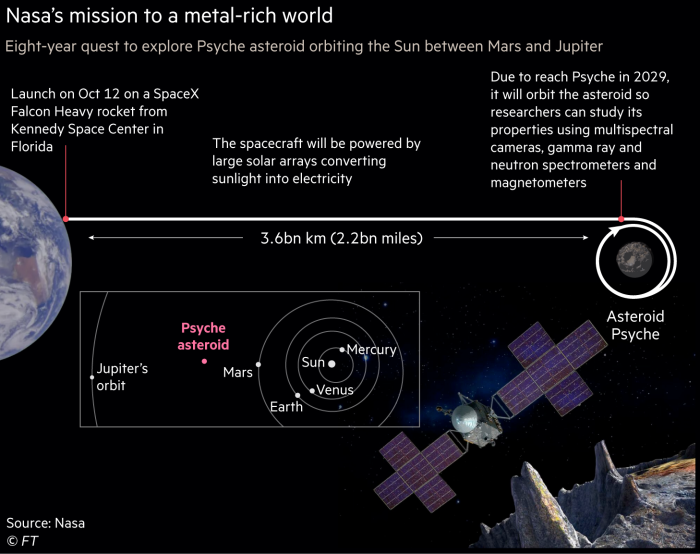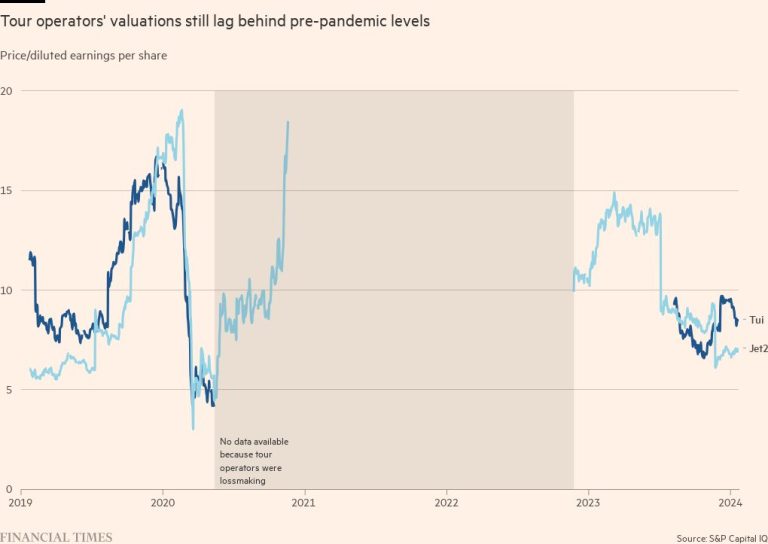Unlock the Editor’s Digest for free
Roula Khalaf, Editor of the FT, selects her favorite stories in this weekly newsletter.
NASA aims to uncover the secret life of the metal-rich asteroid Psyche in a pioneering mission that could offer more clues on Earth’s origins as well as tantalizing insights for mining entrepreneurs and disaster planners.
Due to launch on Thursday, the US space agency’s expedition to an asteroid belt orbiting the sun between Mars and Jupiter aims to reveal how the earth and other rocky planets were formed.
The eight-year venture to outer space’s rubble will be the first chance for a spacecraft to observe a predominantly metallic celestial object, rather than one formed of rock, ice or gases.
The mission to Psyche, named for the Greek goddess of the soul, will also be keenly watched by mining ventures aiming to replenish scarce resources and emergency planners aiming to avert disaster from space detritus hitting Earth.
“It’s primary exploration of a new kind of world,” said Prof Lindy Elkins-Tanton, the Psyche mission’s principal investigator and a planetary scientist at Arizona State University. “There aren’t that many completely unexplored types of worlds in our solar system for us to go see, so that’s what’s so exciting about this.”
The near-$1bn mission is scheduled to take just under six years to reach Psyche. It will then carry out observations for another two years.
Psyche is shaped like a potato and is large by asteroid standards, measuring 280km across at its widest point. It has a surface area roughly equivalent to that of the US state of California.
“We do not know what Psyche looks like,” said Elkins-Tanton, who suggested it might be a place of giant cliffs and bear the scars of greenish-yellow laval flows from sulfur-rich volcanoes. “This is our scientifically motivated idea — almost certain to be completely wrong.”
The expedition’s findings could offer a new window into the origins of planets, including Earth, that are believed to have metallic cores buried deep and inaccessible to exploration. Previous observations, including from a flying stratospheric telescope mounted on a Boeing-747, suggest Psyche is rich in iron.
One hypothesis is that Psyche is the remains of a planetary building block known as a planetesimal that was shorn of its outer layers after it smashed into other objects. A second idea is that it may be the remnants of another type of metallic body formed elsewhere in the solar system.
Asteroids, the detritus of the solar system’s formation about 4.6bn years ago, pose possibilities and threats as well as offering clues to cosmic history. Prospective space mining ventures hope to exploit them for valuable metals, but face big logistical and funding challenges.
Asteroids are attracting further attention because of the potential for one to collide catastrophically with Earth. NASA last year crashed a satellite into the space rock Dimorphos, in a test of its latest deflection technology.
NASA is due on Wednesday to unveil its first-ever asteroid sample, which it delivered to Earth last month from carbon-rich Bennu. The agency hopes the ancient rocks and dust it collected will contain organic molecules similar to those present at the start of life on Earth.
The Psyche mission will be carried out by a van-sized satellite launched from Florida’s Kennedy Space Center on a Falcon Heavy rocket provided by Elon Musk’s SpaceX. NASA hopes it will start beaming images back to Earth as soon as it locates the asteroid in about six years’ time.
The mission will involve the first use beyond the Moon’s orbit of an innovative method of solar-powered ion propulsion. The so-called Hall thrusters work by passing electromagnetic fields through the gas xenon, which is used on Earth in car headlights and plasma TVs.
The gas emissions give the thrusters a striking blue glow, recalling the spacecraft imagery created by the first science fiction filmmakers decades ago.












+ There are no comments
Add yours